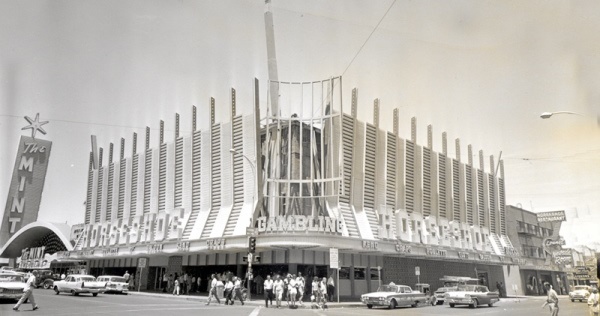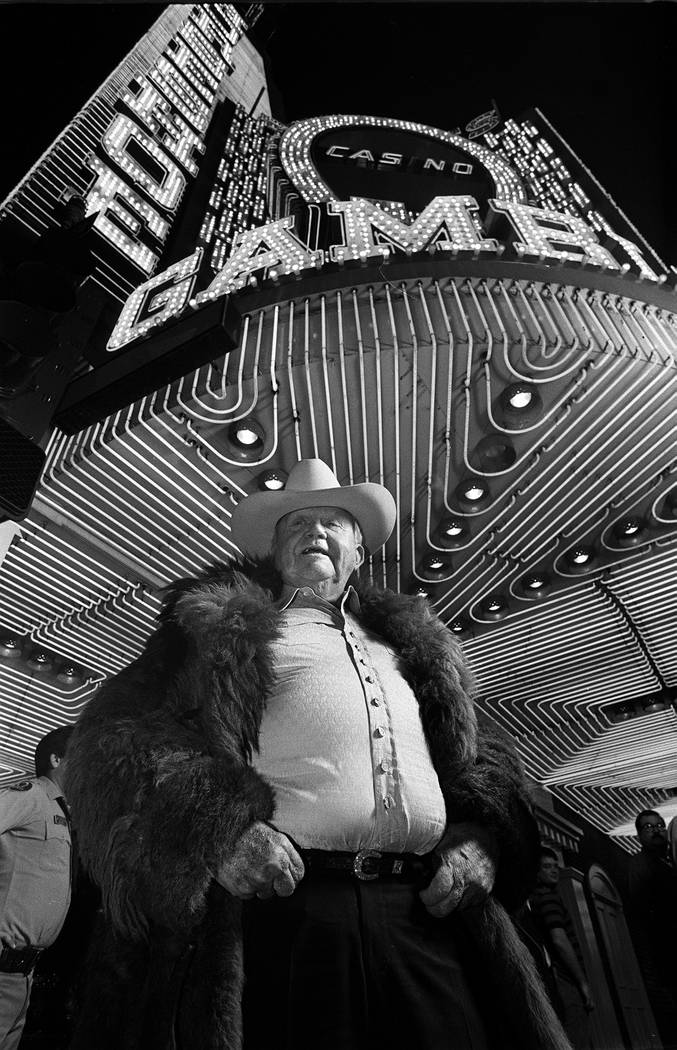Benny Binion
Binion believed fellow bootlegger Frank Bolding had stolen some liquor in 1931, and argued in a backyard with him. 'This guy was a real bad man, and he had a reputation for murdering people by stabbing them,' Binion 's friend, the late Lonnie 'Ted' Binion, related after Benny died. But such was the dual life of Benny Binion—one of Las Vegas’ founding fathers (owner of Binion’s Casino in Las Vegas and founder of the World Series of Poker) and also one of Jordan, Montana’s most colorful characters. But just about the time Binion got started in Vegas he also staked his claim in Jordan. BENNY BINION MIGHT NOT RECOGNIZE HIS OLD JOINT. His name still flashes in gold lights above Fremont Street in downtown Las Vegas, but the atmosphere at Binion’s Horseshoe Hotel and Casino is. Benny Binion was born on a Texas farm in 1901 and began trading horses for a living when he was just 10 years old. Through the years, he raised some of the best bucking and pickup horses in rodeo. ProRodeo Hall of Fame stock contractors such as Harry Knight, Lynn Beutler, Harry Vold and Mike Cervi have owned Binion horses. Benny Binion, father of the WSOP, was a man of many contradictions: wise but illiterate, a marketing genius who always told the truth. Generous to his friends, hospitable to his customers and dangerous to his enemies, Johnny Hughes remembers Binion through his own words.
1990 Inductee
Benny Binion
Industry Leader
Benny Binion (1904-1989) is a pioneer in downtown Las Vegas gambling and poker.
Born in Pilot Grove, Texas, Binion developed an early interest in gambling. As a young man, he moved in horse-trading circles and, as most of the horse traders were inveterate gamblers, also became a gambler.

In 1928, Binoin began running a 'numbers' or 'policy' operation in Dallas. During Prohibition, Binion by his own admission 'did some bootlegging' but never ran a profit. Beginning in 1936, he got involved in the 'dice business' (illegal craps games). In 1946, Binion came out on the losing end of electoral politics, and, lacking political protection, was forced to close his operations in Dallas.
While some of his confederates went to Reno, Binion followed J. Kell Houssels to Las Vegas, where he acquired a part ownership of the Las Vegas Club. Binion then built the Westerner, but in 1951 decided to buy the Eldorado Club.
Binion renamed the gambling hall the Horseshoe and immediately installed carpeting--a novel idea for downtown clubs at the time. The Horseshoe was, from the beginning, a family affair; his two sons, Ted and Jack, supervised the games and his wife Teddy Jane kept the books.
The Horseshoe gained a reputation for high limits, the trademark of Binion's approach to gambling.
In 1970, Binion hosted the first World Series of Poker, then a small tournament of truly elite players. The World Series was both a poker tournament and a premier advertisement for the casino. Other marketing efforts included the famous $1 million dollar display and a working stagecoach that traveled the rodeo circuit.
In 1988, the Horseshoe acquired its next-door neighbor the Mint. The Horseshoe's neon facade soon enveloped the Mint, and the Mint's highrise tower gave the Horseshoe a bevy of hotel rooms and a new vertical prominence.

Binion died on Christmas Day, 1989, and left behind a tremendous legacy, both for his downtown casino and his role in creating high stakes tournament poker. Though the casino he once ran is no longer called the 'Horseshoe,' it is still known as 'Binion's,' in recognition of the patriarch's memory and reputation.

The Western corner of Second and Fremont
This is one of the most storied corners on Fremont Street due mainly to the larger than life Texan who found his fame and fortune when he opened the Horseshoe Club. But before it was the Horseshoe Club, the corner had already been making history:
Becky Binion
Hotel Apache
Built in 1932, this was the first building in Las Vegas to have an elevator. It's brick facade is still there hidden behind the Binion's signage. The Apache also had stain glass windows and some of those are still there. The Hotel Apache had a lavish bar and downstairs in the Garden Room, the ladies of the Mesquite Club would hold their meetings there. Over drinks at the bar, local businessman and civic booster, Big Jim Cashman convinced hotelier Tommy Hull that Las Vegas was the perfect place to build his next hotel. Cashman pushed for Hull to build the hotel on Fremont Street. Hull was convinced that Las Vegas was the place to build. But when it came time to build, he bought the property at San Francisco (now Sahara Ave.) and the Los Angeles Highway (now Las Vegas Blvd. South), just over the county line. Why? Because the taxes were lower in the county.
Benny Binion History
The hotel operated above the Apache Casino and while the owners of the downstairs would change frequently over the years, the upstairs remained the Hotel Apache until the early 1960s.
Western Casino, S.S. Rex and El Dorado Club
The Apache Casino gave way to the new Western Casino which then became the SS Rex when bootlegger Tony Cornero (who had come to Las Vegas in the early 1930s and opened a nite club called the Meadows which had a devasting fire a few years later). He named the casino after one of his gambling boats off the coast of Southern California. When the authorities raided his gambling boats, Cornero came to Las Vegas where gaming was legal. The SS Rex offered craps, faro and other games of chance. In addition, it had a race wire for those who wanted to bet on the ponies.
Dogged by accusations of rigged games, Cornero sold his interest in the Rex and returned to Los Angeles. He would return to Las Vegas in the years ahead. In the meantime, the partners sold the SS Rex and, in 1947, it became the El Dorado Club.
Benny Binion and the Horseshoe Club
Benny Binion Family
In 1951, that larger than life Texan, Benny Binion- having gotten a good taste of gaming in Las Vegas as a partner of Kell Houssels, Sr. bought the El Dorado Club and renamed it the Horseshoe Club.
Breaking with traditional 'sawdust joint' interior, Binion installed carpet. The Binion family went to work to make the Horseshoe Club the go to casino on Fremont Street. Wife Teddy Jane handled the books while sons Jack and Tedworked the floor. Benny and Doby 'Doc' Cahill were good buddies and could often be found eating the Shoe's famous chili in the coffee shop at lunchtime.
Benny had left Texas, some say under rather hurried circumstances, and there is ample evidence that Benny had been involved in illegal bootlegging, gaming and the mob back in Texas. These connections made it difficult for Binion to get licensed but he finally pulled it off. He offered southern hospitality and high limit gaming and the Horseshoe was doing a land office business when in 1953, the Feds got him for tax problems. Before 'he went to college' (the local speak for him doing jail time), Benny sold the Horseshoe to Joe W. Brown. While Binion was in prison, Joe W Brown had his own name put on the facade though everyone knew that when he got released Benny would buy back the Horseshoe.
Benny was away at 'college' for four years, and when he returned he bought back the Horseshoe. It wouldn't be until 1964, though, that he owned 100% of it. He removed Joe W. Brown's name from the facade and hired Yesco to design a neon facade for the building. Because of his stint in prison, Benny was never issued a new gaming license but he was understood to be the man in charge of the Horseshoe.
Benny was known to be hard man and did not tolerate cheats. Stories abound of his largesse and of his temper. Just as many stories abound of punishment of those he felt had cheated while playing at the Horseshoe. He was widely known for accepting all bets. He conducted business out of his office, the booth in the Horseshoe restaurant. His recipe for success: 'If you wanna get rich, make little people feel like big people... good food cheap, good whiskey cheap, and a good gamble. That's all there is to it, son.'
In 1970, Benny made news by hosting the first World Series of Poker. Unlike today's tournament, this was a small, but very elite group of poker players who made their living at playing the game professionally. Benny also had a milllion dollars encased in a over-sized horseshoe shape and put it on display. People came from around the world to have their pictures taken standing next to the display.
In 1988, the Binion family bought the Mint and expanded the Horseshoe so that it took up the entire block. Benny passed away on Christmas Day, 1989. Despite all the stories and whispers about him he was honored, along with MoeDalitz, as one of the most philanthropic men of his era.
Jack Binion continued to run the Horseshoe until 1998, when in a dispute with his sister, Becky, he surrendered control of the casino. Jack went to the South and opened Horseshoe Clubs in Shreveport and Tunica as well as in Hammond,Indiana. Becky, unlike her brother, seemed to have little skill at running the Horseshoe. She sold off the Million Dollar Display and finally in 2004, the Horseshoe in bankruptcy, she sold the family business to Harrah's Entertainment. Harrah's had bought Jack Binion's Horseshoe Clubs as well. Harrah's sold the Horseshoe building to MTR Gaming but kept the rights to the Horseshoe Club name. MTR hired Federal Heath Sign Company to redesign the neon facade. Neon designer Brian 'Buzz' Leming was the designer and the Horseshoe was rechristened Binion's. While the bullnose on the corner was off, you could see the Hotel Apache facade still there behind it.
Teddy Jane Binion passed away a few years back. Son Ted was the victim of a sensational murder and the subsequent trial made headlines for months. A statue of Benny Binion on horseback stands near the hotel today. The Binion family ranch and house on Bonanza and Rancho is still standing though vacant and boarded up.
Updated on June 27th,2007
It's been announced that MTR Gaming Group, which took over Binion’s in 2004 from Harrah's Entertainment who kept the name Horseshoe, is selling the 55-year-old downtown casino to TLC Casino Enterprises for $32 million in cash. TLC also owns the Four Queens downtown. The deal has to close by the end of the year (though TLC can request a six-month extension). It needs the approval of the Gaming Regulators and the City of Las Vegas.
I think Benny is spinning in his grave. How about you?